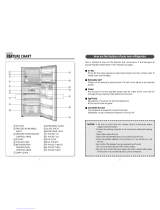
12
SLOW ICE CUBE FREEZING
1. Turn temperature control to colder settings.
2. Door may have been left open
3.Use small ice maker, make’s ice more quickly..
ICE CUBES HAVE ODOUR / TASTE
1. Ice storage box needs to be emptied, washed and old cubes need to be discarded.
2. Unsealed packages in the refrigerator and/or frozen food storage compartments
may be transmitting odour taste to ice cubes.
3. Interior of the refrigerator needs cleaning.
FRESH OR FROZEN FOOD STORAGE COMPARTMENT TEMPERATURE
TOO WARM
1. Temperature control not set cold enough. Refer to temperature control section.
2. Hot food stored without cooling.
3. Blocked air duct in freezer compartment.
4. Warm weather, frequent door opening.
5. Door left open for too long.
CABINET LIGHT NOT WORKING
1. The LED burned out.
2. No power supply.
FREEZER NOT FREEZING PROPERLY
1. Product with high sugar content may not harden completely when frozen (ice-cream,
concentrated juice etc.).
2. Adjust the freezer control to a colder setting.
3. Move the food away from the air vent (near the controls).
4. Turn down the refrigerator temperature control.
SIZZLING SOUND IN FREEZER
Normal sound caused by defrost water dripping on defrost mechanism.
CAUTION :
Improper use of the grounding plug may result in a risk of electric shock. If a
grounding adapter is used, make sure the receptacle box is fully grounded.
- Method of Replacing Supply cord : If the supply cord is damaged, it must
be replaced by the manufacturer its service agent or similarly qualified person
in order to avoid hazard.
- Method of replacing LED : Do not replace the LED lamp yourself, it must only
be replaced by either the manufacturer or the authorised service agent.
- Please keep the keys away from children for safer operation.
- This refrigerator ( Food Freezer ) shall be protected against indirect contact in
accordance with the heavy current regulation.
WARNING: Keep ventilation openings, in the appliance enclosure or in the
built-in structure, clear of obstruction.
WARNING: Do not use mechanical devices or other means to accelerate the
defrosting process, other than those recommended by the manufacturer.
WARNING: Do not damage the refrigerant circuit.
WARNING: Do not use electrical appliances inside the food storage
compartments of the appliance, unless they are of the type recommended by
the manufacturer.
- Do not store explosive substances such as aerosol cans with a flammable
propellant in this appliance.
- This appliance is intended to be used in household and similar
applications such as
– staff kitchen areas in shops, offices and other working environments;
– farm houses and by clients in hotels, motels and other residential type
environments;
– bed and breakfast type environments;
– catering and similar non-retail applications.
!
DOOR CLOSING NOISE
Door closer latch may have some noise during door closing, which is normal.
















